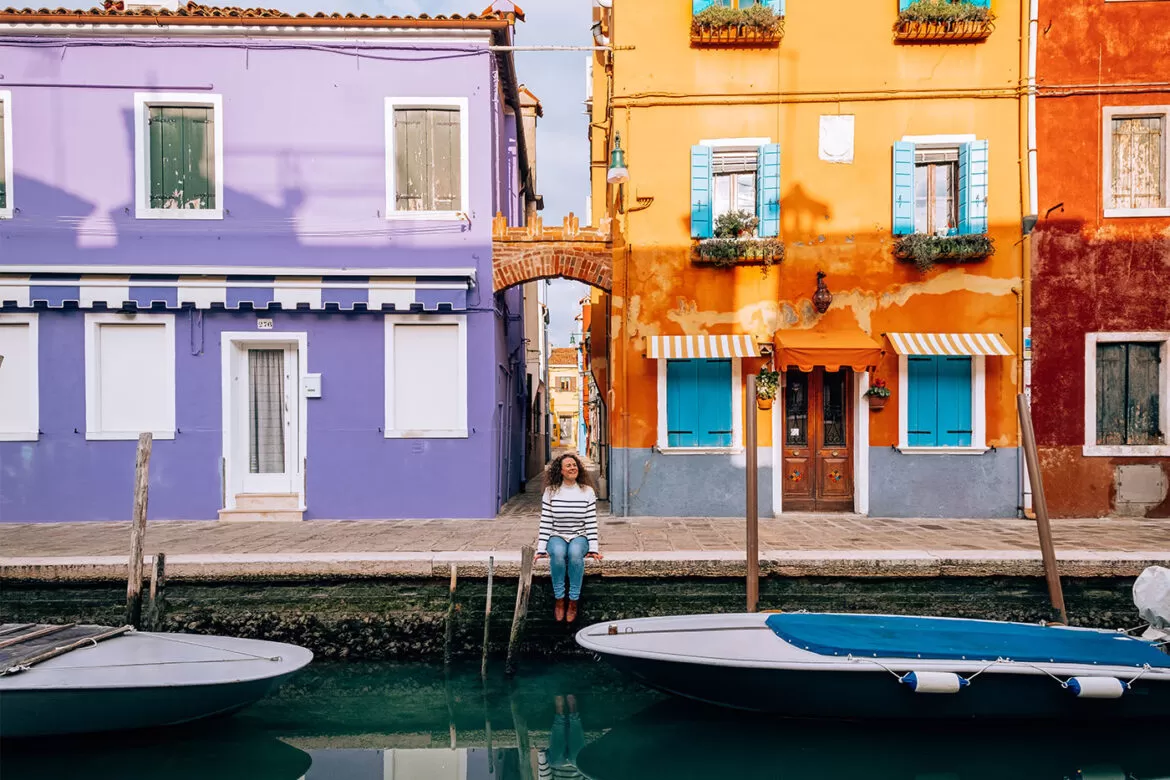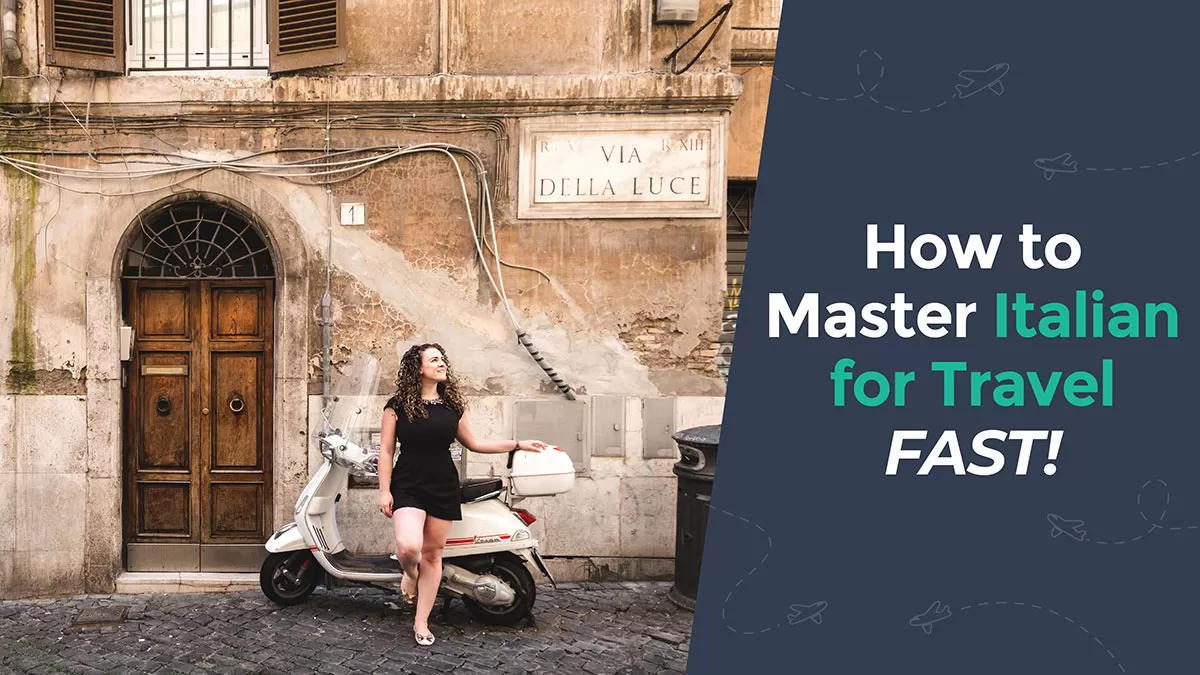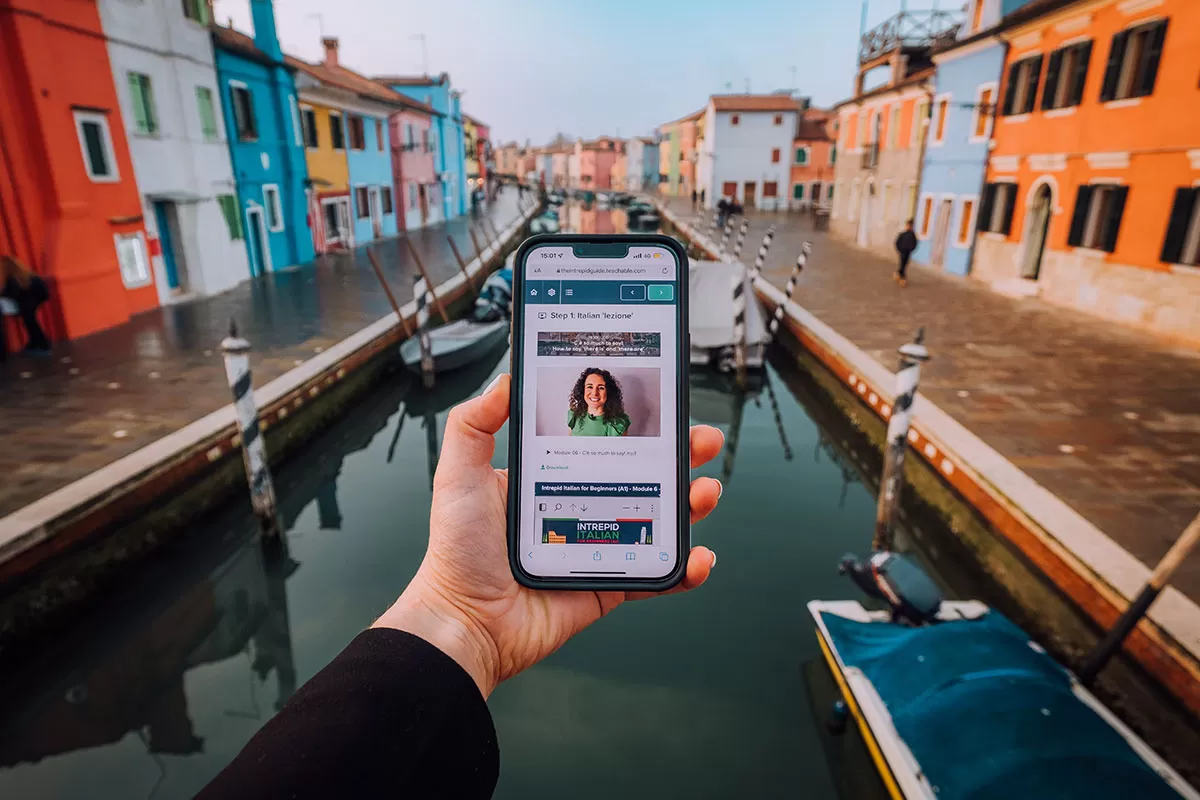With over 50 UNESCO world heritage sites, 3 active volcanoes, over 1500 lakes, excellent food, top-notch wines and the smallest restaurant in the world (that’s right: it can only seat two people!), Italy is one of the most popular destinations for travellers around the world. Despite being a relatively small country, Italy really has something for everyone: gorgeous beaches, stunning cities, archaeological sites, art, countryside and mountains.
It’s not uncommon to experience so-called culture shocks, which are nothing more than cultural diversities, customs or local peculiarities that can cause visitors to feel in over their heads. Sometimes this can lead to scams, paying too much, and general disappointment or confusion.
There’s so much to know about Italyand consider before planning a trip, but don’t worry: whether you’re a first-timer or a returning visitor, here’s everything you need to know before travelling to Italy!
In this guide, you’ll find 33 Italy travel tips and hacks divided into categories which will help you make the most of your time and avoid possible challenges you’ll run into while visiting Italy. Knowing these things will ensure you have a safe and enjoyable stay on each one of your trips. Want more tips? Get my complete guide to 101 Italy travel tips here.
Tips for getting around, travelling and transport in Italy
- Pack light. Steps, inclines, cobblestones, narrow hotel staircases: getting around Italian cities can be a struggle with lots of suitcases and heavy luggage. Whatever your travel style, choose appropriate bags to make sure your arrival and your stay go smoothly. If you’re visiting places like Venice, you will also need to be able to carry your luggage on waterbuses and up flights of stairs as lifts/elevators are very rare.
- Wear comfortable shoes. For the same reason mentioned above, you’ll make your life a lot easier by wearing comfortable shoes when you’re out and about. If you plan to visit Venice, don’t forget you might need a pair of stivali di gomma, rubber boots, when high water occurs in lower-lying parts of the city such as sound Piazza San Marco.
- Validate your train ticket. If you’re travelling by train in Italy, make sure you validate your ticket before getting on the train. Italy doesn’t have turnstiles at its train stations, it is up to you to validate your ticket in the machines (usually green or yellow) located near the entrance to each platform. Hefty fines apply to those travelling with an unvalidated ticket!Emergency tip: If you can’t find a machine, it doesn’t work, or you’re in a hurry, the next best thing you can try is to write on the ticket the time it was last used. This might just be enough to convince a ticket conductor on board that you intended to do the right thing.
- Book high-speed trains in advance. High-speed trains in Italy are called “frecce”, like Freciarossa, Frecciabianca, Frecciargento. Bookings usually open 120 days before your trip. It’s always a good idea to buy tickets in advance to ensure you get a cheaper price. You can get your tickets on the Trenitalia website which is the official Italian rail network ticket provider. There is also Italo, the official private seller of the Italian high-speed train company.
- Beware of transportation strikes. One word sciopero (pronounced: shoh-peh-roh) this is the Italian word for strike and a must-know term. Strikes have become part of daily life in Italy so don’t be shocked if there’s a strike of some sort that may affect your travel plans. Be prepared and pay attention to signs, especially in train stations. Usually, strikes are announced ahead of time so you have the chance to think of a plan B or C.
- Be aware of parking lines. Before parking your car, always check the colour of the lines. White means it’s a free or time-restricted free parking (in this case you need to display a disco orario, that is, a parking disc or clock disc showing the time at which the vehicle was parked). Yellow parking lines mean that the space is reserved for residents in that area or street and it’s forbidden to park there unless you have a permit. Areas marked with blue lines mean you need to pay to park. This normally applies on weekdays and Saturdays but not on Sundays and public holidays, but it’s always better to check the signs. Just like for the motorways, bring some coins, as some parking machines do not accept cards.
- Only use official taxis. All taxis in Italy are white with official markings. Standard prices are listed inside the taxi and on the door. Remember to check these to avoid being scammed. I’ve seen this happen a lot in Rome. Often at airports, you will see people trying to convince unassuming tourists to get a ride with them. Unless the car is white and a marked taxi, don’t risk it.
Food and drink tips
- No cappuccino after breakfast. Ordering a cappuccino together with your meal for lunch or dinner is definitely frowned upon in Italy! Italians normally have a cappuccino (or milk or caffellatte) for breakfast, which often comes with sweet (and not savory) food such as biscuits, pastries, croissants or cereals. This is why you typically don’t order un cappuccino or any other beverage containing milk after 11 am. It’s quite common though to have an espresso, a macchiato (black coffee with a few drops of milk) or a corretto (black coffee with a tiny bit of grappa or other liquor) after a meal. Check out my guide on how to order food and drink in Italian.
- Ask for the bill. In Italy, when dining in a restaurant, you need to ask for il conto (the bill) or go to the cash register to pay. It’s considered rude for the waiter to give you the bill before you’ve asked for it as they just don’t want to rush you. Mealtime is precious in Italy :)
- Drink from water fountains. Water fountains are found in many Italian cities. In Rome, these are called “nasoni” (literally, “big noses”) and provide fresh, cool water. So there’s no need to pay for bottled water. These aqueducts have been supplying Rome with its water for thousands of years! If it’s good enough for the emperors it’s good enough for me :) Bring an empty bottle and fill it up as you explore the city.
Tips for Eating out in Italy
- Dinner is eaten late. Italians typically eat late, from 9 pm, especially in southern Italy. A restaurant serving dinner around 5-7 pm is catering to tourists and therefore the quality of food is often lower. Normally, good restaurants don’t open before 7 pm, unless they’re establishments that also serve aperitivo, a drink (alcoholic or not) that comes with crisps and other nibbles. This can be a good solution to “calm” your hunger while waiting for dinnertime or to stimulate your appetite.
- Italy doesn’t have a tipping culture. No one will judge you if you don’t tip the waiter/waitress. Although, in highly touristic areas it’s become kind of usual and some might even expect it, especially if the service was attentive and punctual, the food tasty and the overall experience pleasant. Italians will only ever leave up to 1-2 euros per person. Learn the dos and don’ts when it comes to tipping in Italy with my complete guide.
- Learn how to express your dietary requirements. Even though in touristic cities people may understand or speak some English, don’t always take it for granted. Learning how to order your meal, your favourite dish and how to express any dietary requirements (e.g. I’m vegetarian, I’m gluten intolerant, I’m allergic to peanuts) in Italian is essential and will ensure that your lunch or dinner runs smoothly.
- Don’t ask for tap water. Even though it’s common in many countries to ask for tap water in restaurants, you will get a disapproving look in Italy. It’s just not common in Italy so if you want to drink water it will be bottled. Just specify if you want it naturale (still) or frizzante/gassata (sparkling).
Italy Sightseeing tips
- Some businesses take a break during the day. In Italian cities, very rarely you’ll find a 24/7 store, let alone in small towns. While in some large shops it has become more common to have an orario continuato (non-stop working hours), generally every Italian store or venue closes right after lunch (12 pm or 1 pm) and then reopens at 3 pm or 4 pm, after the riposino (nap, rest), which is the equivalent of the Spanish siesta. Monday is usually a day off for shops, mini-markets, restaurants, hairdressers and beauty salons. Make a note of business hours, just in case.
- Check public holidays. Public holidays can affect your travel plans and the ability to visit attractions. The most important ones to know are: 1st (New Year’s Day) and 6th (Epiphany) January, Easter and Easter Monday, 2nd June (Republic Day), 15th August (Ferragosto), 1st November (All Saints), 8th (Immaculate Conception), 25th (Christmas) 26th (Saint Stephen/Boxing Day) December. Individual cities also have local festivities. Check the opening hours of each individual attraction if travelling during these times.
- Avoid queues. Book private tours and skip the line tickets in advance for major attractions to avoid disappointment. It’ll be a huge time saver! My favourite go-to service for finding the best-guided tours is Viator.
- Dress appropriately when visiting religious places. You will need to cover your shoulders and your knees before going into religious buildings, like churches and cathedrals or you could be turned away. Avoid carrying large backpacks as they will be denied entry or you will have to use the cloak.
Italy Safety tips
- Beware of pickpockets. Pickpockets can be terrible in some tourist areas and especially on the buses, metros and trains. Avoid the number 64 and 40 bus in Rome when travelling to the Vatican from Termini station. These lines are notorious.
- Never leave your credit card out of your sight. Don’t let your credit card unsupervised when paying for anything. I’ve heard stories of waiters taking their card to swipe using a machine “out the back” of the restaurant. Thirty minutes later, the card had been cloned and they had apparently bought 3,000 Euros worth of jewellery, paid for a taxi, purchased 500 Euro worth of sports equipment and 200 Euros of groceries all over Italy in a span of an hour.
- Always have your ID with you. In Italy, it is required by law to carry your personal ID with you. You may be asked to show it if stopped by police officers on duty.
- Learn Italian emergency numbers. Should you have an emergency while in Italy, you can call 112 (European Emergency number) for general emergencies, 113 for polizia (National Police), 115 for firefighters and 118 for health emergencies.
- Learn some basic Italian. Even though Italy is a highly touristic country, don’t expect everyone to understand or speak English. It’s a good idea to learn some basic Italian phrases for everyday situations but also in case of emergency – God forbid!
- Know where to find public toilets. To access public toilets in Italy you will often need to pay a euro or two. However, the law requires bars and restaurants to give access to their facilities for free. Common practice is to make a small purchase or to take a quick espresso drunk at the counter. Local city apps, like Veritas in Venice, will help you find public restrooms.
- Bring a plug adaptor. Check the voltage before using your appliances (remember that most hotels provide things like hair dryers anyway) and make sure you have the right adaptor for Europe and Italy. For Italy, there are three plug types, types C, F and L. Plug type C has two round pins, plug type F has two round pins with two earth clips on either side and plug type L has three round pins in a row. Italy’s supply voltage is 230V and 50Hz.
- Consider getting travel insurance. Italy has one of the best public healthcare systems in the world and you will always get assistance if needed. With that being said, it’s worth looking into travel insurance which can cover costs for other unexpected incidents such as loss of luggage, unforeseen cancellations or theft. Get a free quote from World Nomads here.
Italy Accommodation tips
- You need to pay city tax. Each person must pay city tax or tourist tax. This is not included in your bill and must be paid separately once you arrive at your accommodation. This fee is set per person per night, it must be paid in cash and is usually around 2 euros. Visiting Rome? From the Spanish Steps to the Pantheon, don’t miss my guide to the best hostels and neighbourhoods in Rome. For more tips, don’t miss my guide on the best time to travel to Italy.
- Don’t expect air conditioning everywhere. Double-check that your hotel or car rental has air conditioning, as this is not standard and usually it’s not available unless specified. When there is air-conditioning, expect it to be weak. If you are used to the US air-con standard, you will notice that Italian air-conditioned spaces feel significantly warmer than those back home.
Types of establishments in Italy
- Use plastic gloves when handling baked goods, fruit and vegetables at the supermarket. It’s a common thing in Italy to wear plastic gloves which are found near the scales. Once you pick your items, you’ll also have to weigh them yourself, enter the product code, print the sticker, and put it on the plastic bag. This can’t be done at the checkout and you’ll be sent back.
- Learn about Italian farmacie. Pharmacies in Italy are run by real pharmacists (and not just shop assistants), who give medical advice and strictly sell pharmaceutical products and health articles. Even things like aspirin are kept behind the counter. The business hours of pharmacies are typically 8 am to 8 pm and they generally have a lunch break from 1 pm to 4 pm. However, in case of an emergency, there is always a pharmacy open. You can find the address and phone number of the farmacia di turno (pharmacy on duty) written on all pharmacy doors. Pharmacies are marked by large green crosses lit by LED lights.
- Go to thetabaccherie. Tabaccherie are newsagents that sell almost anything from cigarettes and tobacco to magazines and newspapers, candy/sweets, snacks and local transport tickets. They can easily be identified by their signage: a large white “T” on a black or blue background.
Travelling with children in Italy
- Most restaurants don’t have a kid’s menu. Kids menus are not very common in Italy but this doesn’t mean a restaurant is not child-friendly. You can easily ask for a simple pasta dish or a mezza porzione (smaller portion) of whatever is on the menu, they will be happy to do that.
- Car seat for children. Not all rental companies have the full equipment for children. If you’re travelling with a baby who needs a rear-facing car seat, consider bringing your own car seat and make sure it complies with the EU safety standards.
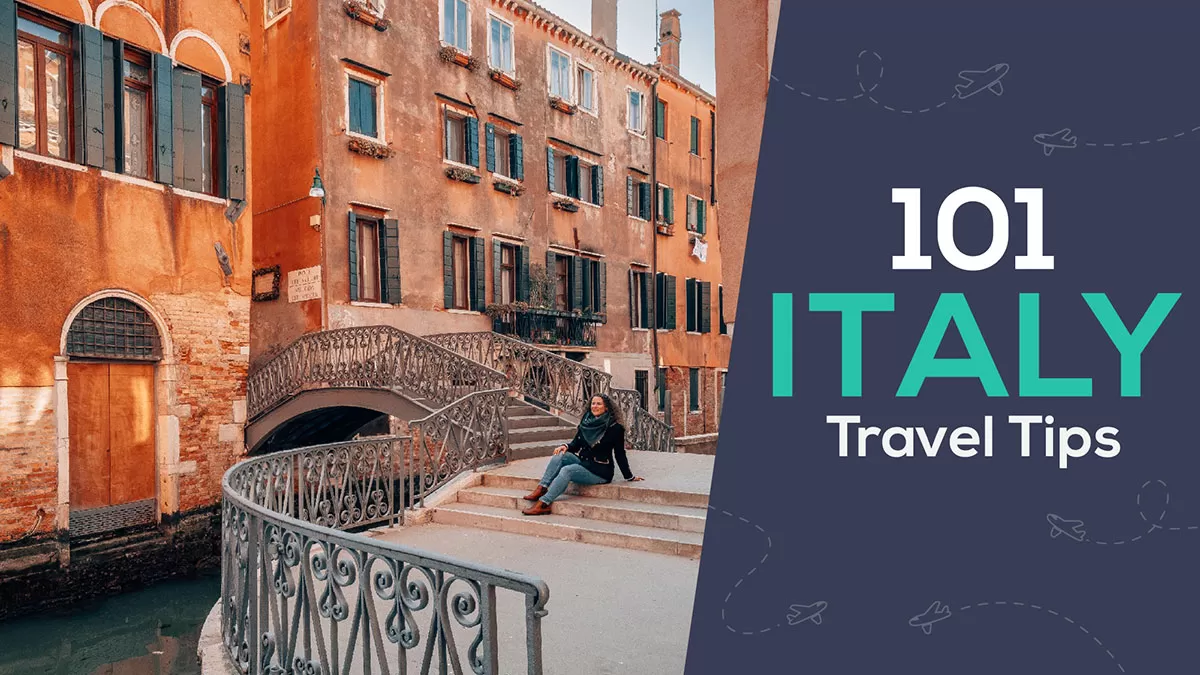 Want more Italy travel tips? Get my complete guide which features 101 Italy Travel Tips that will save you more time, more money and disappointment.
Want more Italy travel tips? Get my complete guide which features 101 Italy Travel Tips that will save you more time, more money and disappointment.
I wish you many wonderful and memorable trips to come. Buon viaggio! (Have a wonderful trip)
Don’t be treated like a tourist. Learn Italian with my 80/20 method
Travelling to Italy? Don’t be treated like a tourist! Live your best travel experiences and learn Italian for less than the cost of eating at a tourist trap restaurant or a taxi driver who has “taken you for a ride”. I’ve made it easy for you to master the Italian language so you can create lifelong memories as you mingle with locals, get local tips, avoid tourist traps, and make new friends. Who knows, you may even be invited over for afternoon tea by a lovely Sicilian family like I was! Read all about how speaking Italian changed my lifeand check out my online Italian video course here.
Here’s what my students are saying:

I really enjoyed the Intrepid Italian course, it certainly exceeded my expectations. The learning methodology is great,and easy to follow and found that Iprogressed much faster in the last 4 weeks than I ever did on my own or using other language apps. Grazie mille Michele, I can’t wait until I can put my new skills into action!- Roma Small
Click here for instant access!
Don’t miss my Italy travel guides
- Best Time to Visit Italy // PLUS Tips to Avoid Crowds and SAVE $$$
- 29 Amazing Day Trips from Rome By Train, Car & Guided Tour
- 21 Unique Things to Do in Venice You Should Try at Least Once
- Where to Stay in Rome | Best Hotels and Best Neighborhoods to Stay in Rome
- 20 Top Hotels Near the Pantheon in Rome for Every Budget
- 12 BEST Things to do in Burano, Italy (Tips from a Local Guide)
- Top 7 Authentic Tours and Experiences in Rome [Run by Locals]
- Domus Aurea: Why You Should Visit Rome’s Secret Hidden Palace
- Rome Tips and Tricks: 27 Things You Should Know Before You Go to Rome
- Top 10 Absolute Best Views of Rome That Will Blow Your Mind
- Self-Guided Trastevere Walking Tour: Where to See Rome’s Most Beautiful Streets
- 26 Absolute Best Things to do in Verona, Italy
- Lakes, Mountains & Castles: 21 Best Things to do in Trento, Italy
- 36 Wonderful Things to do in Umbria, Italy (PLUS Map of Umbria)
- Italy Fun Facts: 126 Unique Things You Didn’t Know About Italy
Planning a trip and need travel insurance? Get a free quote from World Nomads here.
Like it? Pin it for later!
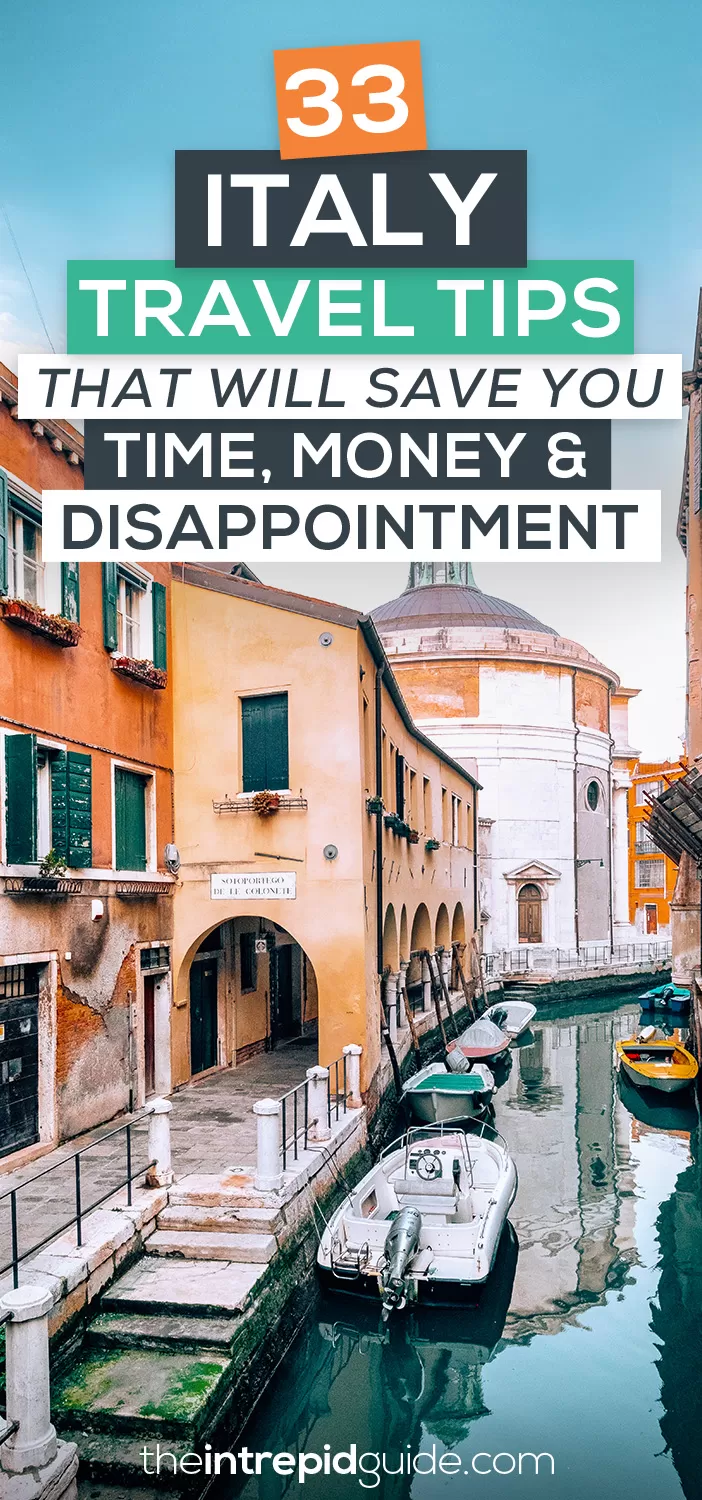
Over to you!
Have you visited Italy before? What other tips would you add to this list?
Let me know using thecomments section below or join me on social media to start a conversation.
Thanks for reading and I hope you enjoyed this post.
Like what you see? Subscribe using the form below to have all of my posts delivered directly to your email.

